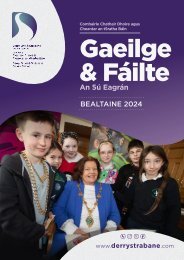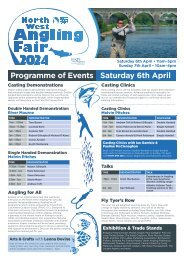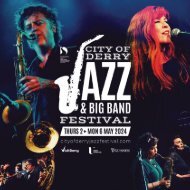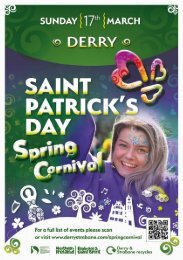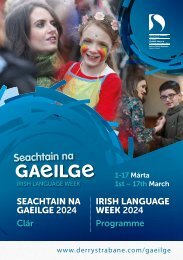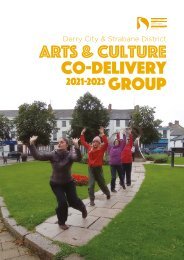Derry & Strabane: Natural Capital Report of Outdoor Recreation Spaces 2021
An analysis of the true social, health, economic and environmental value of green and blue spaces in our District using Natural Capital Accounting.
An analysis of the true social, health, economic and environmental value of green and blue spaces in our District using Natural Capital Accounting.
Create successful ePaper yourself
Turn your PDF publications into a flip-book with our unique Google optimized e-Paper software.
Methodology annex<br />
4<br />
The <strong>Natural</strong> capital account for the public<br />
greenspace in DCSDC area draws on<br />
methodologies developed for the Greenkeeper tool.<br />
Greenkeeper is an online tool designed to support<br />
planning and investment decisions around<br />
Green Infrastructure in cities across the UK. The<br />
methodologies underlying the tool were used to<br />
develop the 2019 and 2020 NCAs for DCSDC area.<br />
Greenkeeper uses data on visit patterns,<br />
greenspaces characteristics, and evidence on the<br />
social, economic and environmental benefits <strong>of</strong><br />
Green Infrastructure. Using the economic analysis<br />
and valuation skills <strong>of</strong> Vivid Economics, the<br />
health and wellbeing expertise <strong>of</strong> the European<br />
Centre for Environment and Human Health and<br />
the understanding <strong>of</strong> the planning and design<br />
process brought by Barton Willmore, Greenkeeper<br />
uses newly available datasets, technologies and<br />
insights to assess current performance and<br />
opportunities for any urban greenspace in the UK.<br />
The data for the 2020 NCA was provided by<br />
DCSDC, ONS, Forestry Commission, and MENE<br />
Survey including Vivid Economics Analysis. Data<br />
on visits to publicly-owned and accessible spaces<br />
have been provided by:<br />
• <strong>Derry</strong> City & <strong>Strabane</strong> District Council owned<br />
& managed sites;<br />
• Department <strong>of</strong> Agriculture, Environment &<br />
Rural Affairs (Forest Service, Inland Fisheries<br />
& NIEA)<br />
• Department for Communities (NIHE & North<br />
West Development Office)<br />
• Department for Infrastructure (Roads Service)<br />
• Loughs Agency<br />
• Office <strong>of</strong> First & Deputy First Minster<br />
• Ulster University<br />
• Western Health & Social Care Trust<br />
• Woodland Trust<br />
• Rugby, cricket, football & gaelic pitches<br />
The value <strong>of</strong> greenspace assets is estimated<br />
in terms <strong>of</strong> physical health, mental wellbeing,<br />
amenity value methodology, and carbon<br />
sequestration.<br />
20<br />
The value <strong>of</strong> mental wellbeing is based on<br />
improvements in life satisfaction reported by<br />
adult park visitors.<br />
Individuals who spend more time<br />
in greenspaces report higher levels<br />
<strong>of</strong> life satisfaction than those who<br />
spend less time in greenspaces.<br />
The value <strong>of</strong> life satisfaction from greenspace<br />
visits is calculated by quantifying the amount <strong>of</strong><br />
money that would lead to an equivalent increase<br />
in life satisfaction. The total value per greenspace<br />
is a product <strong>of</strong> the number <strong>of</strong> visits per year, the<br />
share <strong>of</strong> visits made by low and high duration<br />
visitors, and the value per visit by visitor type.<br />
Physical health benefits are calculated<br />
separately for low and high activity adult<br />
visitors. Low activity visitors undertake some<br />
exercise in greenspaces but do not meet NHS<br />
recommendations. High activity visitors meet<br />
NHS physical activity recommendations. The<br />
health benefits for low activity visitors are<br />
calculated by measuring the reduction in risk<br />
<strong>of</strong> all-cause mortality from their exercise in<br />
green space. The risk reduction is expressed in<br />
the quantity <strong>of</strong> fatalities prevented, then given<br />
a monetary value using the Department for<br />
Transport (DfT) value <strong>of</strong> a prevented fatality (VPF).<br />
In contrast, the health benefits for high activity<br />
visitors are calculated by measuring the number<br />
<strong>of</strong> Quality Adjusted Life Years (QALYs) gained<br />
through exercise in green space.<br />
The QALYs gained is expressed in monetary terms<br />
using the HM Treasury Green Book value <strong>of</strong> a<br />
QALY. As a result, the total value per greenspace<br />
is a product <strong>of</strong> the number <strong>of</strong> visits per year, the<br />
share <strong>of</strong> visits made by low and high activity<br />
visitors and the value per visit by visitor type.<br />
Importantly, mental wellbeing and physical health<br />
value only capture value to adult visitors. It is<br />
assumed that adults make up for 75% <strong>of</strong> estimated<br />
visits to the green spaces and 50% <strong>of</strong> visits to<br />
playparks.








